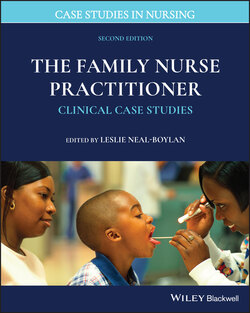Читать книгу The Family Nurse Practitioner - Группа авторов - Страница 28
ОглавлениеCase 3.3 Burn
By Mikki Meadows‐Oliver, PhD, RN, FAAN
SUBJECTIVE
Two‐year‐old Faye presents to the office with her mother, Kellie, with a complaint of a burn to the right hand. Kellie states that she was curling her hair in the bathroom when her telephone rang. She left the bathroom to retrieve the telephone. While she was answering the telephone, Faye entered the bathroom and pulled on the curling iron cord that was hanging down below. The incident was unwitnessed, but Kellie heard Faye scream. She ran to the bathroom to find both Faye and the curling iron on the floor. She then noticed that Faye’s right hand was red and swollen. She immediately brought her in to the office. Faye has no symptoms of illness.
Diet: Faye’s nutrition history reveals that she has a balanced diet with enough dairy, protein, fruits, and vegetables. She has not eaten since she burned her hand.
Elimination: She is voiding well with no complaints of dysuria. She is not yet toilet‐trained.
Sleep: Faye sleeps 10 hours at night and has no trouble falling or staying asleep. She takes one 2‐hour nap during the day.
Past medical history: Faye was born via vaginal delivery at 37 weeks’ gestation. Since being discharged at 2 days of age, she has had no hospitalizations. She had an emergency department (ED) visit 3 months ago for ingestion of cigarette butts. Faye passed her developmental screening at her last well‐child visit. She currently attends an in‐home day care while her mother is working. Faye has no chronic illnesses and is currently taking no medications.
Social history: Faye lives at home with her 18‐year‐old mother, 6‐month‐old sibling, and maternal grandmother. Her father is not involved. Faye’s mother works as a nurse’s aide in a long‐term care facility. The family has 2 cats. There are no smokers in the home.
Family medical history: Faye’s mother (18 years old) and father (19 years old) are healthy and have no history of chronic medical conditions. Kellie did have high blood pressure with both pregnancies but the condition resolved after she delivered her children. Her maternal grandmother (age 34 years) has thalassemia trait. Her maternal grandfather (35 years old) is healthy with no chronic illnesses. The health history of Faye’s paternal grandfather is unknown. Her paternal grandmother (40 years old) has a history of obesity and high blood pressure.
Medications: Faye is not currently taking any over‐the‐counter, prescription, or herbal medications. She has no known allergies to medication, food, or the environment. She is up to date on required immunizations, although her mother declines the flu vaccine yearly.
OBJECTIVE
Faye’s vital signs are taken, and her weight in the office is 14 kg. Her temperature is within the normal range at 37.2°C (temporal). She is alert, crying at times, but consolable. She appears well hydrated and well nourished.
Skin: The skin on the palm of her right hand is erythematous and beginning to blister. The affected area is painful to touch. The rest of her skin is without lesions. There is no cyanosis of her skin, lips, or nails. There is no diaphoresis noted, and Faye has good skin turgor on examination.
HEENT: Faye’s head is normocephalic. Her red reflexes are present bilaterally; and her pupils are equal, round, and reactive to light. There is no ocular discharge noted. Faye’s external ear reveals that the pinnae are normal, and there is no tenderness to touch on the external ear. On otoscopic examination, the tympanic membranes are gray bilaterally and in normal position with positive light reflexes. Bony landmarks are visible, and there is no fluid noted behind the tympanic membranes. Both nostrils are patent. There is no nasal discharge and no nasal flaring. Faye’s mucous membranes are noted to be moist. She has 20 teeth present. There are no lesions present in the oral cavity.
Neck: Faye’s neck is supple and able to move in all directions without resistance. There is no cervical lymphadenopathy present.
Respiratory: Her respiratory rate is 28 breaths per minute, and her lungs are clear to auscultation in all lobes. There is good air entry, and no retractions or grunting are noted on examination. No deformities of the thoracic cage are noted.
Cardiovascular: Faye’s heart rate is 106 beats per minute with a regular rhythm. There is no murmur noted upon auscultation.
Abdomen: Normoactive bowel sounds are present throughout and Faye’s abdomen is soft and nontender. There is no evidence of hepatosplenomegaly.
Genitourinary: Normal female genitalia without erythema or lesions.
Neuromusculoskeletal: Good tone and full range of motion in all extremities. Her extremities are warm and well perfused. Capillary refill is less than 2 seconds, and her spine is straight.
CRITICAL THINKING
1 Are there any laboratory tests or diagnostic imaging studies that should be ordered as part of a workup for a burn?
2 What additional diagnoses should be considered for a pediatric patient with a burn?
3 What is the plan of treatment, referral, and follow‐up care?
4 Does this patient’s psychosocial history affect how you might treat this case?
5 What if the patient lived in a rural setting?
6 Are there any demographic characteristics that might affect this case?
7 Are there any standardized guidelines that should be used to assess or treat this case?
